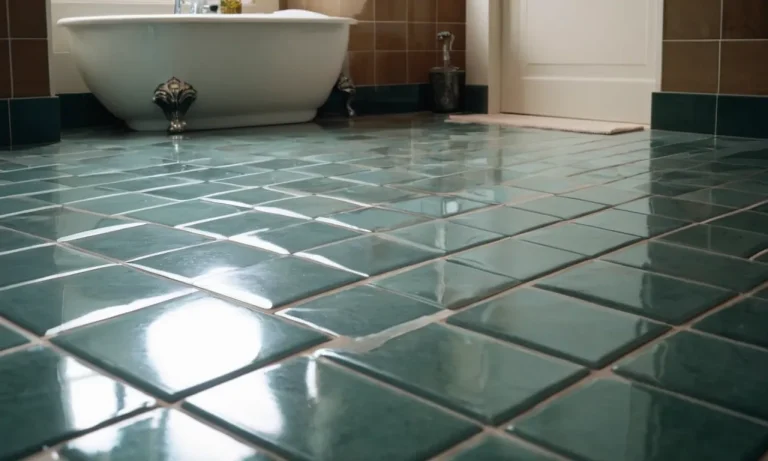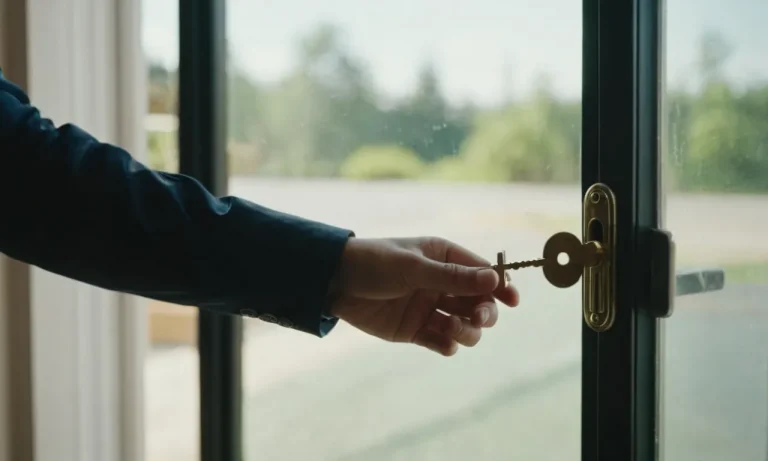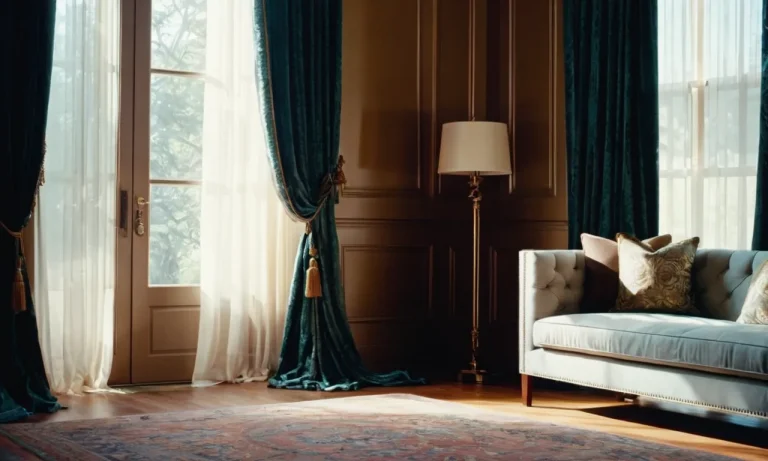Can You Put Curtains Over Blinds?
If you’re looking to customize your window treatments, you may be wondering if you can put curtains over blinds. The short answer is yes, you can install curtains over blinds for a layered window covering look.
Curtains and blinds serve different purposes and pairing them offers both privacy and light control along with a stylish, decorative touch.
In this comprehensive guide, we’ll discuss the benefits of layering curtains over blinds, provide tips on how to choose complementary styles, and outline the best installation methods. Read on to learn everything you need to know about successfully coordinating curtains and blinds.
Benefits of Putting Curtains Over Blinds
Add an extra layer of privacy and light blocking
One of the main benefits of putting curtains over blinds is the added layer of privacy and light blocking. While blinds can provide some privacy and light control, adding curtains can enhance these features.
The thick fabric of curtains can effectively block out unwanted light and prying eyes, creating a more private and comfortable space. Whether you live in a busy neighborhood or simply want to create a cozy atmosphere, curtains over blinds can provide the extra layer of privacy and light control you desire.
Soften hard window lines for a cozier look
Another advantage of combining curtains with blinds is the ability to soften the hard lines of windows, giving them a cozier look. Blinds can sometimes appear cold and rigid, especially in modern or minimalistic interiors.
By adding curtains, you can introduce softness and warmth to your windows, making the space feel more inviting. The flowing fabric of the curtains can create a sense of elegance and comfort, transforming the overall aesthetic of the room.
Layer colors, patterns, and textures
Putting curtains over blinds also allows you to layer colors, patterns, and textures, adding depth and visual interest to your windows. You can choose curtains that complement or contrast with the colors of your blinds and the overall décor of the room.
This gives you the opportunity to express your personal style and create a unique and visually appealing window treatment. Mixing different fabrics and patterns can also create a more dynamic and sophisticated look.
Quick and easy way to refresh your windows
If you’re looking for a quick and easy way to refresh the look of your windows, adding curtains over blinds is a great option. Swapping out or adding curtains can instantly change the vibe of a room without the need for major renovations or expensive upgrades.
With a wide variety of curtain styles and colors available, you can easily find options that match your existing blinds and décor. It’s a simple and cost-effective way to update the appearance of your windows and breathe new life into your space.
Versatility to adjust privacy, light, and style
The versatility offered by combining curtains and blinds is unmatched. You have the flexibility to adjust the amount of privacy and light entering the room by simply opening or closing the curtains and adjusting the blinds.
This allows you to create the perfect ambiance for any time of day or any occasion. Additionally, curtains come in various styles, from sheer to blackout, allowing you to choose the level of privacy and light control that suits your needs.
This combination of functionality and style makes curtains over blinds a popular choice among homeowners.
What to Consider When Pairing Curtains and Blinds
Window size and shape
When deciding to pair curtains and blinds, it is important to consider the size and shape of your windows. Different window sizes and shapes may require specific types of blinds and curtains to ensure a proper fit.
For example, larger windows may benefit from wider curtains or multiple curtain panels, while smaller windows may be better suited for narrower blinds and shorter curtains.
Blinds type: roller, cellular, wood, etc
Another factor to consider is the type of blinds you have or plan to install. There are various types of blinds available, such as roller blinds, cellular blinds, wood blinds, and more. Each type has its own unique features and aesthetic appeal.
It is important to choose blinds that not only complement your curtains but also meet your functional needs, such as light control and privacy.
Curtain style: tab, grommet, back tab, rod pocket
The style of your curtains also plays a significant role in pairing them with blinds. There are different curtain styles to choose from, such as tab-top, grommet, back tab, and rod pocket. Each style offers a different look and functionality.
For example, tab-top curtains create a relaxed and casual look, while grommet curtains provide a contemporary and sleek appearance. Consider the overall style of your room and choose curtains that harmonize with your blinds and decor.
Curtain length and fullness
The length and fullness of your curtains can greatly impact the overall look when paired with blinds. Curtain length should be determined by the height of your windows and the desired effect you want to achieve.
Floor-length curtains can create a dramatic and elegant appearance, while shorter curtains can give a more casual and modern feel. Additionally, the fullness of the curtains can add depth and texture to the window treatment.
Consider the amount of fabric needed to achieve the desired fullness and adjust accordingly.
Curtain and blinds textures, colors and patterns
The textures, colors, and patterns of both your curtains and blinds should be taken into account when pairing them together. The combination of textures can add visual interest and dimension to your windows. For example, pairing a textured blind with a smooth curtain can create an appealing contrast.
Similarly, coordinating colors and patterns can help tie the curtains and blinds together and create a cohesive look. Experiment with different combinations to find the perfect balance that complements your overall decor.
Tips for Choosing Complementary Styles
When it comes to window treatments, combining curtains and blinds can add depth and versatility to any room. If you’re considering putting curtains over blinds, here are some useful tips to help you choose complementary styles:
Match or contrast textures
A great way to create visual interest is to match or contrast the textures of your curtains and blinds. For example, if you have sleek and modern blinds, you can choose curtains with a soft and flowing texture to add a touch of elegance to the room.
On the other hand, if your blinds have a textured fabric, you can opt for sheer or lightweight curtains to create a more layered look.
Coordinate colors
Coordinating the colors of your curtains and blinds can help create a cohesive and harmonious look. You can choose curtains in a color that complements or matches the color of your blinds. Alternatively, you can select curtains in a contrasting color to add a pop of color and create a focal point in the room.
Choose complementary patterns
If you’re feeling adventurous, you can mix and match patterns between your curtains and blinds. However, it’s essential to select patterns that complement each other rather than clash. For example, if your blinds have a bold pattern, you can choose curtains with a more subtle pattern or a solid color.
This will help create a balanced and visually appealing look.
Mix curtain lengths and fullness
Experimenting with different curtain lengths and fullness can add depth and dimension to your window treatment. For instance, you can layer a shorter curtain over a longer one or choose curtains with varying lengths for a more dynamic look.
Additionally, opting for full and flowing curtains can create a luxurious and elegant feel.
Consider room decor style
When choosing curtains and blinds, it’s essential to consider the overall decor style of the room. Take into account the furniture, color scheme, and architectural elements. For example, if you have a minimalist and modern room, you may want to choose sleek and simple blinds paired with sheer curtains.
On the other hand, if your room has a more traditional or eclectic style, you can opt for curtains with intricate patterns and heavy fabrics.
Remember, the key is to experiment and have fun with your window treatments. By following these tips, you can create a beautiful and harmonious look by combining curtains and blinds in a way that complements your style and enhances your space.
How to Hang Curtains Over Blinds
Measure window correctly
Before you start hanging curtains over blinds, it’s important to measure your window correctly. Use a tape measure to determine the width and height of your window, ensuring you measure from the outer edges of the window frame.
This will help you choose the right size curtains and curtain rods for your space.
Install curtain rods above or below blinds
When hanging curtains over blinds, you have the option of installing the curtain rods above or below the blinds. Installing the rods above the blinds can create a more seamless and cohesive look, as it allows the curtains to hang freely without interference from the blinds.
However, if you prefer to keep the blinds fully functional, you can install the rods below the blinds. This way, you can easily open and close the blinds while still enjoying the added privacy and style of curtains.
Use clips or rings to hold curtains back
If you want to hold your curtains back to let more light in or create a decorative look, you can use clips or rings to secure them. Attach the clips or rings to the curtain rod and gather the curtains together, securing them in place.
This will not only add a stylish touch to your windows but also allow for more flexibility in controlling the amount of light that enters your space.
Allow proper curtain overlap when closed
When closing your curtains, it’s important to ensure that they have proper overlap. This means that when they are fully closed, there should be enough fabric to cover the entire window, preventing any gaps where light can seep through.
To achieve this, choose curtains that are wider than the actual window frame and hang them with enough space on each side to allow for this overlap.
Check draw alignment and adjust if needed
After hanging your curtains over blinds, it’s essential to check the draw alignment. Make sure that the curtains open and close smoothly without any obstructions from the blinds or curtain rods. If you notice any issues, such as the curtains getting caught on the blinds or not sliding properly, you may need to adjust the position of the rods or the curtain clips/rings to ensure smooth operation.
Now that you know how to hang curtains over blinds, you can easily transform the look of your windows while still enjoying the practicality of blinds. Remember to measure your window correctly, choose the right installation method, use clips or rings to hold curtains back, allow for proper curtain overlap when closed, and check the draw alignment for smooth operation.
With these tips, you’ll have beautifully layered windows that add style and functionality to your space.
Best Curtain and Blinds Pairings
When it comes to window treatments, combining curtains with blinds can create a stylish and functional look for any room. By pairing curtains with blinds, you can enjoy the benefits of both privacy and light control. Here are some of the best curtain and blinds pairings to consider:
1. Sheer curtains with roller shades
For a light and airy feel, sheer curtains paired with roller shades are a winning combination. The sheer curtains add a touch of elegance and softness to the room, while the roller shades provide privacy and block out harsh sunlight when needed.
This pairing is perfect for living rooms or bedrooms where you want to create a cozy yet bright atmosphere.
2. Blackout curtains over cordless blinds
For those who value their sleep, combining blackout curtains with cordless blinds is a great choice. The blackout curtains effectively block out all light, ensuring a dark and peaceful environment for a good night’s rest.
The cordless blinds add an extra layer of privacy and can be easily adjusted to control the amount of sunlight entering the room.
3. Eyelet curtains with faux wood blinds
If you’re looking to add a touch of sophistication to your windows, consider pairing eyelet curtains with faux wood blinds. The eyelet curtains create an elegant and flowing look, while the faux wood blinds add a touch of warmth and natural beauty.
This combination works well in dining rooms or study areas, where you want to create a refined and inviting atmosphere.
4. Rod pocket curtains above cellular shades
For a modern and sleek look, combining rod pocket curtains with cellular shades is a great choice. The rod pocket curtains add a touch of style and can be easily adjusted to create different looks. The cellular shades provide excellent insulation and energy efficiency, making them ideal for bedrooms or living rooms where you want to maintain a comfortable temperature.
5. Tab top curtains with roman blinds
For a classic and timeless look, pair tab top curtains with roman blinds. The tab top curtains offer a casual and relaxed feel, while the roman blinds provide privacy and light control. This combination is perfect for kitchens or bathrooms, where you want to create a cozy and inviting atmosphere.
Remember, the key to successfully pairing curtains with blinds is to choose styles and colors that complement each other and the overall decor of the room. Experiment with different combinations to find the perfect match for your windows!
Conclusion
Layering curtains over blinds allows you to customize your windows with style, privacy, and light control in mind. Measure properly, choose complementary styles, and use the right hardware for hanging.
With the right pairings and installations, you can easily enjoy the perks of both curtains and blinds in any room of your home.







